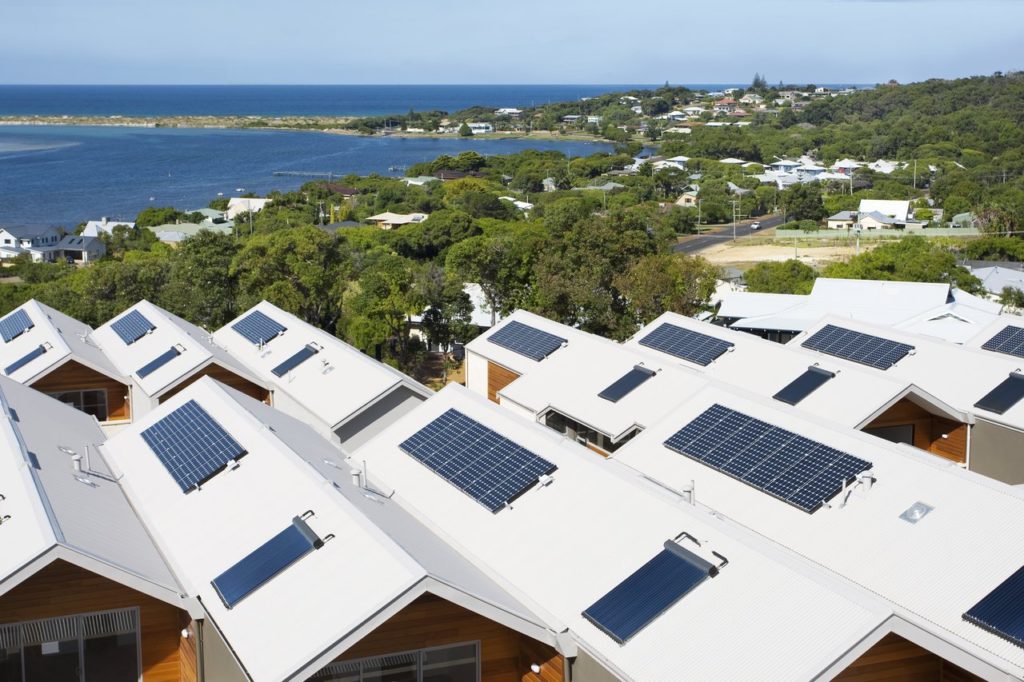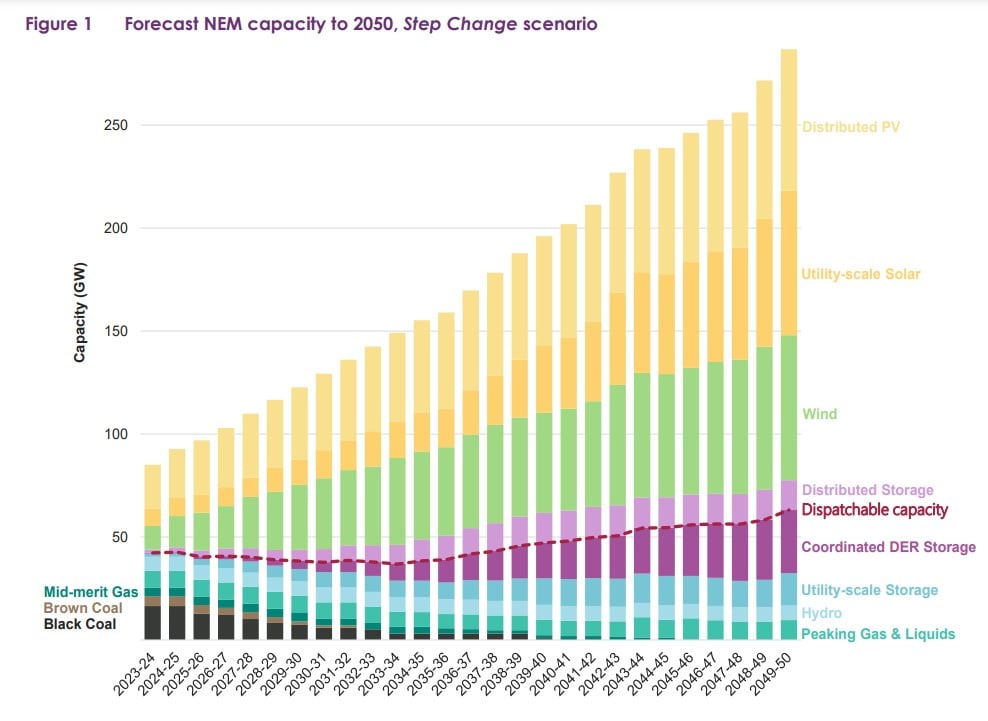
The Australian Energy Market Operator (AEMO) has revealed its 2022 Integrated System Plan (ISP), laying out a 30-year roadmap that plots the transition to net-zero and identifies upcoming investments in the National Electricity Market (NEM), which covers the populous south and east of the country.
AEMO billed the roadmap as a “once-in-a-century transformation in the way electricity is generated and consumed” in the region via replacing “legacy assets with low-cost renewables, add energy storage and other new forms of firming capacity and reconfigure the grid to support two-way energy flow”.
Unlock unlimited access for 12 whole months of distinctive global analysis
Photovoltaics International is now included.
- Regular insight and analysis of the industry’s biggest developments
- In-depth interviews with the industry’s leading figures
- Unlimited digital access to the PV Tech Power journal catalogue
- Unlimited digital access to the Photovoltaics International journal catalogue
- Access to more than 1,000 technical papers
- Discounts on Solar Media’s portfolio of events, in-person and virtual
AEMO collaborated with 1,500 stakeholders – including policy makers, governments, consumers and energy industry representatives – to inform its policy, with contributors agreeing the most likely scenario was to be the ‘Step Change’ one, under which renewables will generate 83% of NEM energy by 2030-31.
It comes at a turbulent time for Australia’s energy market which on 15 June suspended the country’s wholesale power market after a collapse in generation rendered the spot market impossible to operate reliably. The suspension has since been lifted but the forecasted spot price for tomorrow (1 July) in the spot market is expected to be upwards of AU$650/MWh, according to AEMO data.
In its 104-page ISP, AEMO said global energy market volatility and supply chain chaos has resulted in high domestic fuel prices, leading to price caps in the gas and electricity spot markets and “an unprecedented level of market intervention by AEMO”.
“These events only confirm energy security as a driver of the transformation, and the potential for firmed renewables to protect consumers from global commodity shocks,” said AEMO.
The report calls for AU$12 billion investment in NEM’s grid infrastructure to accommodate a massive growth in renewable generation, a significant build out of energy storage systems, widespread market reform, immediate action on key policy areas and investment in skills and training.
Optimal development path calls for significant investment
In order to support the NEM’s transformation towards net zero emissions, the ISP said investment was needed to meet significant increased demand from homes, businesses and transport, which will require a nine-fold increase in utility-scale solar and wind capacity and a near five-fold increase in distributed solar PV.
Investment is also needed to treble the firming capacity from alternative sources to coal that can respond to a dispatch signal, including utility-scale batteries, hydro storage, gas-fired generation and smart behind-the-meter virtual power plants (VPPs).
Markets and networks will also need to be adapted for two-way electricity flow, leveraging AEMO’s Engineering Framework to prepare the power system for 100% instantaneous penetration of renewables, while NEM will need to install more than 10,000km of new transmission lines to connect generators and users.
It also recognised the need for “significant investment in the human and social capital needed to deliver the intended consumer benefits and secure the NEM’s future”.
A double transformation
NEM’s ‘double transformation’ constitutes an electrification of the economy while switching to firmed renewables, said AEMO. The ISP calls for development opportunities in the Optimal Development Path (ODP) that would assist the NEM in catering for:
- Almost double the electricity delivered to approximately 320TWh per year in addition to significant ongoing investment by consumers in distributed energy and energy efficiency as well as the potential growth in green hydrogen production.
- Nearly five times the distributed PV capacity and substantial growth in distributed storage. Already, 30% of detached homes in the NEM have rooftop PV but, by 2032, over half of the homes in the NEM are likely to do so, rising to 65% with 69GW capacity by 2050.
- Nine times the utility-scale variable renewable energy capacity, with much of this being built in renewable energy zones (REZs) that coordinate network and renewable investment.
- Coal-fired generation withdrawing faster than announced, with 60% of capacity withdrawn by 2030.
In its forecast NEM capacity to 2050 under its Step Change scenario, AEMO expects utility-scale and distributed solar to provide roughly 50GW of power by 2030 and close to 150GW by 2050 (see chart).

“As coal-fired generation withdraws and weather-dependent generation starts to dominate, the NEM must efficiently match when and where electricity is generated,” said AEMO, adding “investment is needed to treble the firming capacity provided by new low-emission firming alternatives that can respond to a dispatch signal”.
Part of this would be a massive expansion in energy storage, reaching 46GW/640GWh by 2050, as well as 7GW of existing hydro generation, both storage and run-of-river types, and 10GW of gas-fired generation for peak loads and firming.
Market reforms and two-way electricity flow
Addressing transmission with the NEM will also be vital to its ability to transition to clean power and reach its climate goals, while making sound economic sense. The transmission projects within the ODP are forecast to deliver scenario-weighted net market benefits of AU$28 billion, returning around 2.2 times their cost of approximately AU$12.7 billion, according to AEMO, adding “all of the transmission projects in the ODP are needed”.
“These transmission projects are forecast to deliver $28 billion in net market benefits, returning 2.2 times their cost of $12.7 billion, which represents just 7% of the total generation, storage and network investment in the NEM,” said AEMO CEO, Daniel Westerman.
Power systems on this scale are made more complex by the demands of two-way electricity flow, AEMO noted. It said significant market and technical reforms were underway, such as the five minute settlement and wholesale demand response, in the NEM to manage a secure and efficient transformation to a low-emissions grid.
Future reforms, on the other hand, include a capacity mechanism to create a clear long-term signal for investment in both existing and new dispatchable capacity, essential system services to deliver a number of initiatives to maintain the system’s secure operation and unlock value for consumers, DER Integration into the system, transmission reform and congestion management.
Priority action key to ISP success
“It is imperative that the actionable projects should commence on time, and be developed efficiently to the proposed timetables,” said the report.
There are a range of urgent efforts required to support the ISP’s timely implementation, according to AEMO, including changes to the regulatory framework, financial mechanisms to better align benefits with costs and the timing of their imposition, government investment, underwriting or finance and improved recognition of the impact on landholders and communities hosting the infrastructure.
Moreover, it calls for immediate action on five key projects: HumeLink, VNI West, Marinus Link, Sydney Ring and New England REZ Transmission Link.
“The ISP will help industry participants, investors, governments and communities plan for the decarbonisation of the power system to deliver low-cost, firmed renewable electricity with reliability and security,” said Westerman, adding it will “help meet state and national climate targets, and contribute to economic growth through low-cost, reliable energy.”







